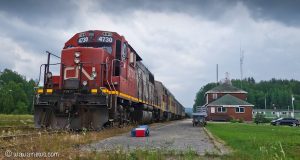Sep 21, 2017 @ 13:12
Howie Wilcox, Chair of the Coalition for Algoma Passenger Trains (CAPT) submitted CAPT’s response to the 25-year provincial transportation strategy. In it he states that the draft Northern Ontario Multimodal Transportation Strategy (NOMTS) “is completely lacking in vision, is not multi-modal, …and does not respond to the input from its community consultations.”
Summary of CAPT’s response to the NOMTS proposed strategy:
The NOMTS report is based on the current transportation that exists NOW, not on what COULD and NEEDS to be developed in the next 25 years. It is based on the fact that in Northern Ontario travellers have no choice but road and air transportation because there is almost no passenger train service. The strategy needs to be far more visionary in order to achieve its stated vision: ‘Northern Ontario’s transportation system is responsive to economic, social and environmental needs and change, and is transformative in supporting new economic activity, healthy communities and a cleaner environment.’
There is a great need to broaden the transportation mix in Northern Ontario in order to move beyond the very narrow focus on exclusively road and air travel.
With the energy crisis and climate change, the need for passenger rail to connect our northern communities with each other as well as with the rest of the province and country has become imperative. When it becomes increasingly dangerous due to extreme weather to drive long distances and the urgency to reduce carbon emissions forces us to use rail, train service will be essential to the future of Northern Ontario. Without it our communities could become ghost towns. The need to attract and retain young people, tourists and immigrants to Northern communities, as well as the needs of the aging population, make passenger rail essential.
Replacing trains with buses does not “modernize” transportation. Rail, on the other hand, is a more modern technological innovation— only a little older than air transportation as a technology. Rail continues to innovate outside Canada. Bombardier, for one, now offers passenger trains that reach 150 km/hour on regular tracks, winter or summer. Most of these trains are running in many countries except Canada because rail is not supported here. Buses are not a comfortable mode of transportation, particularly for seniors and people with disabilities, for long distance travel. From a multi-modal perspective buses are most effectively used as short distance feeder vehicles to transport people to passenger rail lines for longer distance travel. Northern Ontarians urgently need passenger service on the existing tracks to travel to health care, to post-secondary education, for youth retention, to bring tourists to our amazing tourism destinations and to travel long distances in dangerous Northern weather. Our economy, our educational institutions, our health care facilities and our communities are in great need of the reinstatement of passenger train service.
If the province were to extend the mandate of the Ontario Northland Transportation Commission to cover all of Northern Ontario then it is conceivable that improved connectivity of motor coach services and passenger rail to provide these essential services is possible.
The NOMTS report does not even consider passenger rail services such as renewing the ONTC’s Northlander between Cochrane and Toronto. A passenger train from Sault Ste. Marie to North Bay could have easily connected with both the southbound and northbound Northlander adding additional passengers wishing to travel to Toronto and points north. The Ontario government should be advocating on behalf of the remote communities from Sault Ste. Marie to Hearst for Transport Canada to reinstate passenger train service on the ACR line.
With the increasing number of extreme weather events related to steadily increasing climate change, passenger rail provides a safer way to travel, than road and air travel. NOMTS has to take into account the fact that the number and duration of highway closures are increasing.
For passengers with accessibility and health issues, travel for longer distances by train is safer and more accommodating than by bus because trains allow people to stretch through moving around and washrooms are more accessible.
Restoring passenger rail on the existing rail beds in Northern Ontario is one of the fastest ways to respond to climate change as it is a very effective way to reduce carbon emissions and to link people, resources and businesses during our increasingly extreme weather events. The NOMTS report shockingly neglected to propose arguably the fastest and most effective way to reduce GHG: by planning for a well-coordinated, energy-efficient passenger rail service along the existing rail beds in Northern Ontario. Rail stands alone in its ability to combine energy efficiency with economic and environmental benefits. GHG would be reduced considerably by lower fuel consumption and less production and laying of asphalt for road beds due to less damage through fewer vehicles on highways;
Lower health, police and insurance costs would result from greater use of passenger rail. Hazardous road conditions over long distances can increase the number of highway accidents and injuries.
With our vast land mass and sparse population in Northern Ontario, the cost of fuel and climate change: we cannot afford NOT to invest in rail.
The Draft NOMTS Report is not multi-modal
The NOMTS process should have included a SWOT analysis of the different modes of transportation. A SWOT analysis would have evaluated the strengths, weaknesses, opportunities and threats associated with the various modes of transportation. To develop a good transportation strategy, the relative strengths, weaknesses, opportunities and threats vis a vis the various modes should have been assessed to determine for example which modes are most effective for long distance travel, which are better for short distances, which result in the least or most GHGs, which are most likely to function during extreme weather etc. All modes are useful but the appropriate use of each should be based on information about their usefulness for various purposes. For example, based on the environmental, economic and social strengths and weaknesses of buses and trains, feeder buses could be used to transport people for short distances to passenger train lines that would be effective for longer distances.
CONCLUSION
In Southern Ontario, passenger rail connects numerous communities with annual subsidies in the hundreds of millions. If passenger rail service is considered to be a necessity there, then why can’t it be expanded to include the North where it is equally necessary? There is no region like Northern Ontario that has such a great need for a comprehensive rail passenger service that is more accessible and safer than bus service and less expensive than air. Long distances, the need to reduce carbon emissions, and hazardous winter highway conditions are only a few of the justifications for such a service. Northerners should not be treated as ‘second-class’ citizens! The rail beds are there–seize on the opportunity to use them for passenger service not just freight. This message was expressed very strongly at all of the NOMTS community consultations, but it is not reflected in the draft report.
The negative economic impacts of cutting the Northlander and Algoma passenger trains have been huge in Northeastern Ontario. Attracting tourists to far away tourist destinations and students to our northern colleges and universities requires safe and affordable transportation. Both the federal and provincial governments state that tourism is an important economic diversification focus to help replace resource-based industries. But how can the tourism sector flourish when there is no passenger rail. It is common knowledge that most tourists will not drive more than 4 hours in the summer and 2 hours in the winter to reach a tourist destination, but many would be happy travelling the long distances by train. Most communities in Northeastern Ontario have policies to encourage more immigrants and people from southern Ontario to move here. Rail connectivity to the south should be paramount for the success of such plans. Health care in Northern Ontario is highly regionalized. As a result, people have to travel very long distances to receive care. It is unacceptable to expect people with health problems and disabilities to travel hundreds of miles by bus to reach a regional health care centre.
- Municipality of Wawa Partners with SECFDC to Administer Municipal Accommodation Funds - December 10, 2025
- New Chair and Vice Chair for the Algoma District School Board - December 10, 2025
- Sault College Supporting Algoma Steel Employees Through Info Sessions on Retraining, Upgrading and Employment Services - December 10, 2025
 Wawa-news.com You can't hear the 'big picture'!
Wawa-news.com You can't hear the 'big picture'!



Excellent article, very disappointed in the governments report and that they hired the same firm who advised the termination of the Ontario Northland passenger rail service. Blinders were set and locked for this report.
Good article and response to a terrible plan by the government. The NOMTS isn’t worth the paper it’s written on; the next (hopefully not Liberal) government does not need to respect this plan and could waste another 4 years doing more consultations and wasting taxpayer dollars.